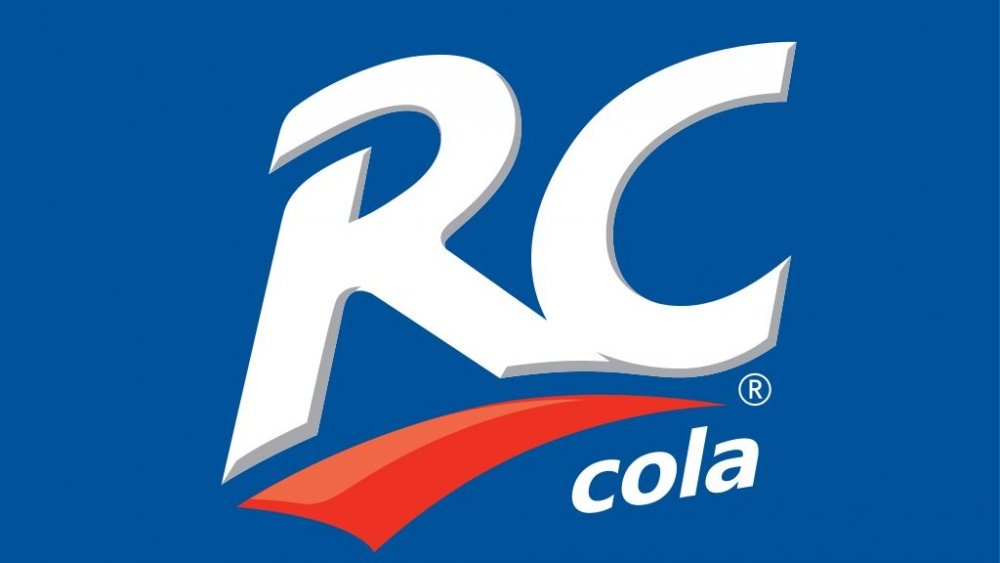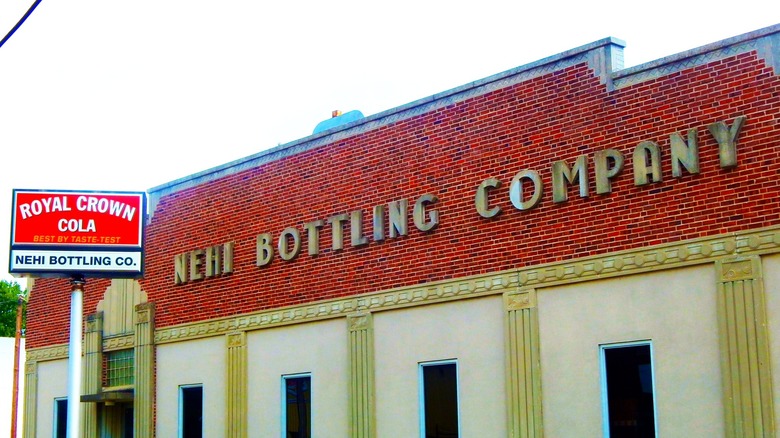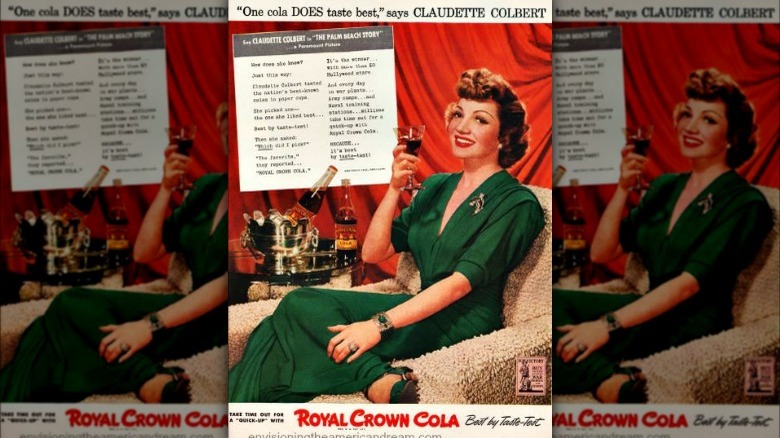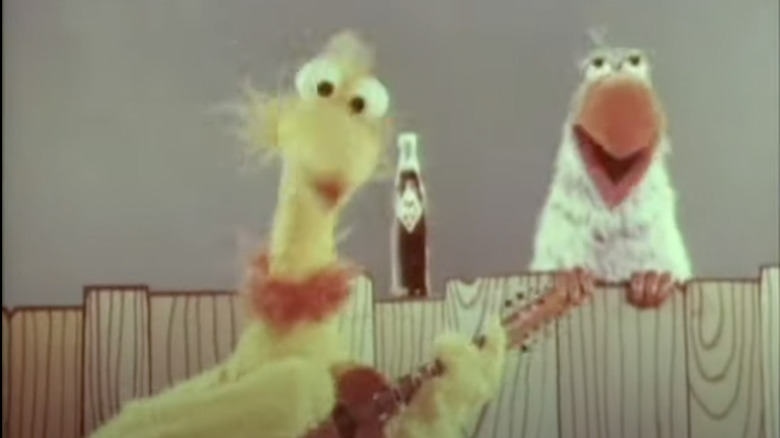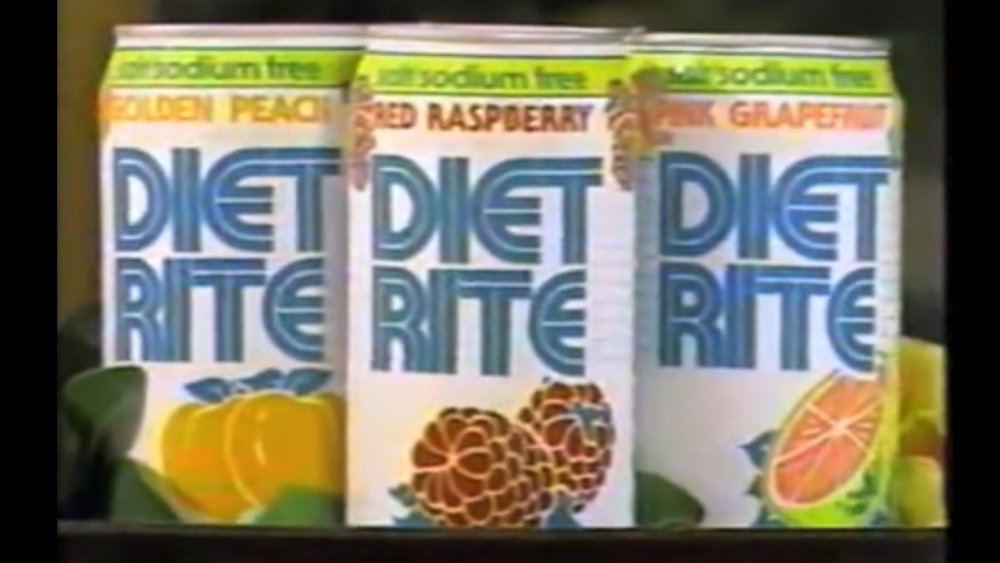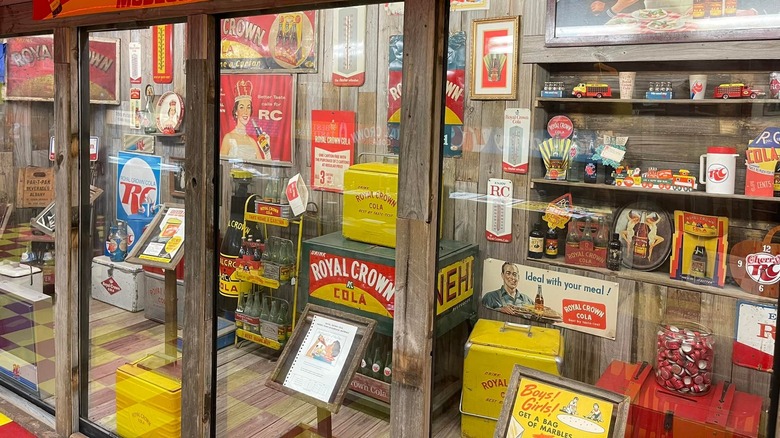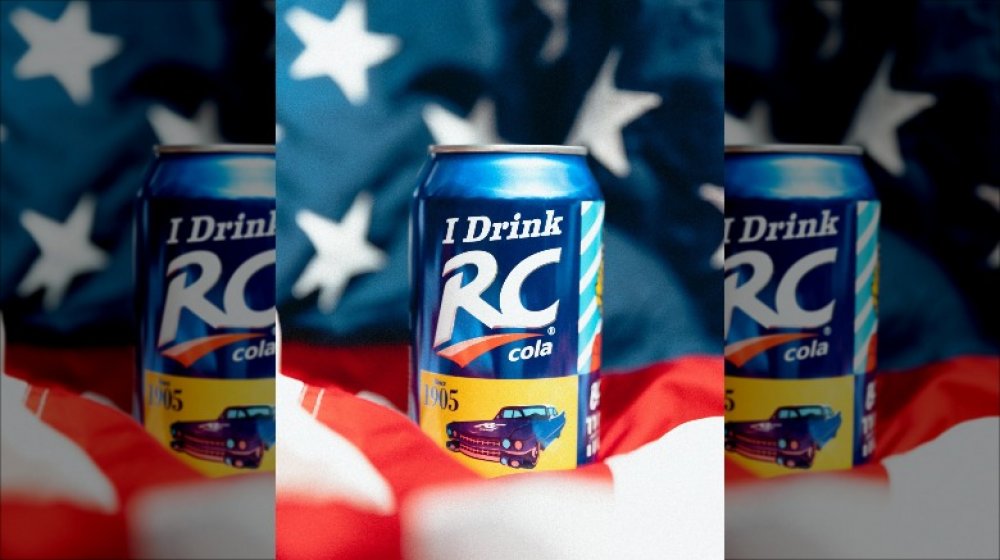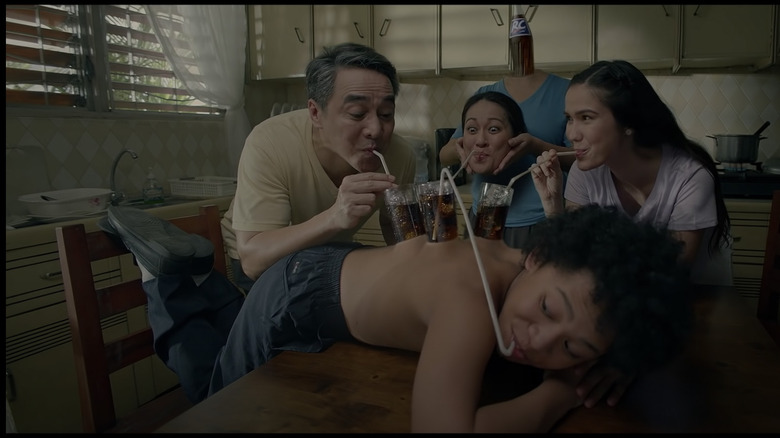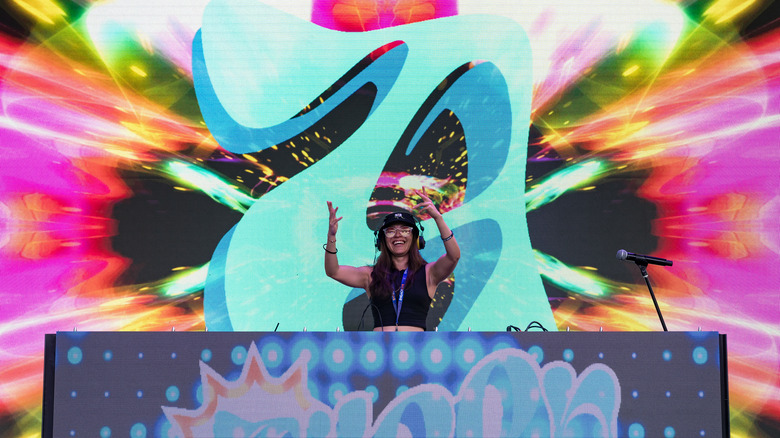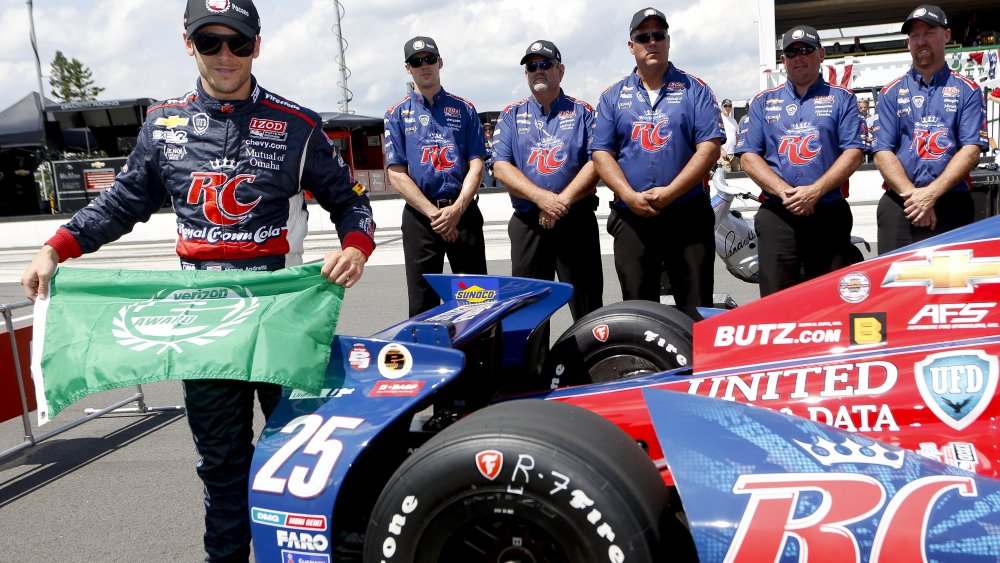The Untold Truth Of RC Cola
RC Cola may not have been the first cola on the market, but it certainly has a long history of trials, tribulations — and innovations. Though it's now a part of the enormous beverage conglomerate Keurig Dr Pepper, RC Cola had humble beginnings in Columbus, Georgia, when a young pharmacist, Claud A. Hatcher, wanted to create and bottle drinks for his family's grocery store. He named his new line of drinks Royal Crown.
But the beginnings of the company were actually spurred by a disagreement between Hatcher and the reigning king of soft drinks (also based in Georgia), Coca-Cola. According to Encyclopedia.com, Hatcher was selling loads of that soft drink to his grocery store customers and believed he should get a side cut of the sales, or at least a cheaper purchase price on the bottles. When Hatcher — then only 27 years old — was denied by one of the soda company's bottlers, he decided to halt Coca-Cola purchases and instead create his own soda recipe in his store's basement. The rest, as they say, is history. Join us as we go through the Royal Crown company's ups and downs. RC Cola might be the distant third-place finisher in the cola wars between Pepsi and Coke, but that doesn't mean it's not important in its own right.
Its first soda was actually ginger ale
Although he was looking to compete with Coca-Cola, Hatcher's first soda was actually Royal Crown Ginger Ale in 1905. The product was an instant success, but there was even bigger money to be made in the cola space, per Encyclopedia.com. The Hatchers decided to challenge Coke with a cherry-flavored cola called Chero-Cola, which debuted in 1907 (via Royal Crown Cola International). The business took off so briskly that the Hatchers soon found themselves in the soda business full time.
The family established Union Bottling Works, later renamed Chero-Cola Company, to sell its hit product, and by 1920 had grown to supply soda syrups to 700 franchised plants for bottling (via New Georgia Encyclopedia). During World War I, the company even started up its own sugar refinery to meet demand during rationing. Unfortunately, Coca-Cola was none too pleased with the "Cola" part of Chero-Cola's name and sued the company, claiming that it owned the term.
Mental Floss reports that Hatcher fought the lawsuit for years as he grew his own business, but in 1923, a judge sided with Coca-Cola, forcing a name change to just "Chero," which negatively impacted sales. The cola was discontinued as Hatcher instead focused the business on his popular fruity soda, which was called Nehi. This led to another company name change, to the Nehi Corporation, in 1928, according to the New Georgia Encyclopedia. However, when the Great Depression hit, Nehi's sales also suffered, and Hatcher died in 1933.
Royal Crown makes a comeback in the 1940s
With the company's sales director, H.R. Mott, now at the helm, sales figures started to improve for the company. Mott nixed production of the worst soda sellers and in 1934 brought Chero-Cola back as a plain (not cherry-flavored) cola called Royal Crown, in honor of the line's origins. Over the next decade, sales would jump tenfold, and the Nehi Corporation was back in the game (via Mental Floss).
According to RC Cola's official history, the new Royal Crown cola was perfected over six months by a chemist named Rufus Hamm. The work paid off as the soda became popular immediately and turned the company's fortunes around. By the '40s, the soda had reached 47 of the contiguous United States. Advertisements from this period of the brand's history featured the era's biggest stars, like Bob Hope and Bing Crosby.
Overall, the '40s were a very successful decade for Royal Crown. In 1940, the company had the idea to hold publicly-performed blind taste tests versus competitors — and won (via RC Cola International). Meanwhile, a judge ruled in 1944 that the word "cola" was again fair game for manufacturers, so the company was renamed once more as Royal Crown Cola Company.
Jim Henson created commercials for RC Cola
Generations of children (and adults) have grown up with Jim Henson, whether by watching "The Muppet Show" or "Sesame Street" with their casts of lovable characters — Kermit the Frog and Big Bird, anyone? What tends to get left out of the puppeteer's biography, however, is his stint producing television ads. Long before either program aired on TV, his puppets starred in commercials for products including coffee, bread, and Frito-Lay's Munchos, which showcased an early prototype of Cookie Monster (via YouTube).
One of the companies to tap Henson was RC Cola, and in 1966 he made an array of commercials starring puppets Nutty Bird and Sour Bird. Each clip follows the same template: Nutty Bird enthusiastically preaches RC Cola's greatness, while Sour Bird glowers from a fencepost, adding sarcastic commentary along the way. In one exchange showing Nutty Bird wailing on an acoustic guitar, Sour Bird grumpily asks if he's done singing. Nutty Bird replies "There is no end to the praises I sing of Royal Crown Cola!" (per YouTube).
Around 20 seconds long, the ads combined a playful mix of slapstick comedy and music, which would define the whimsical worlds Henson would introduce audiences to years later. Only four commercials were made, and to our knowledge it remained the only collaboration Henson did with Royal Crown. Still, it's an interesting peek into the pair's early days. Shortly after, Sour Bird would appear in a sketch on The Ed Sullivan Show (via Loveland Reporter-Herald).
Royal Crown made the first popular diet cola
Now with some momentum, Royal Crown contributed plenty more innovations to the soda scene. According to the New Georgia Encyclopedia, the company manufactured the first nationally-available canned sodas in 1954, then created bigger 16-ounce bottles in 1959. Royal Crown was also the first company to unleash diet soda on the masses. The company's first diet beverage, released in 1958, was called Diet Rite. It was later followed by a caffeine-free version called RC 100 and a cherry-flavored variety, Diet Cherry RC. The diet sodas were created for diabetics, but they proved to be a hit with weight-watchers, too (via Our Everyday Life).
Though the RC brand claims that Diet Rite was the first diet cola, there had been other diet sodas before — but none on a national scale, as Diet Rite achieved by 1962 (via Culinary Lore). Unfortunately, the diet soda generated controversy due to the inclusion of cyclamates as a sweetener, which was eventually banned in 1970 over health concerns.
Since Diet Rite had helped Royal Crown sail to the No. 1 diet-soda spot, the health scare caused the company's sales to plummet. In a strange twist, the company diversified by acquiring two fruit juice makers and seven home furnishings companies, followed by the fast-food chain Arby's (via Mental Floss). Unfortunately, the company's next owner, Victor Posner (who took over in 1984), later received a conviction for tax evasion and was also under suspicion of insider trading.
Soda fans can visit the RC Cola Museum
Columbus, Georgia is the birthplace of RC Cola, and in many ways, the soft drink industry — tourists can embark on the Soft Drink Heritage Trail, per Historic Columbus. It's inevitable, then, that the fountain beverage would enjoy some sort of historical tribute. If you venture to Rivermarket Antiques on Hamilton Road, you'll find the RC Cola Museum showcasing rare memorabilia and knick-knacks related to the drink, including a syrup dispenser that's the only one of its kind (via WRBL).
The museum, which opened last year, has been a hit with visitors. Owner Allen Woodall told WRBL the museum is dedicated to the locals who built RC Cola from the ground up, either working in its bottling plants or selling it in mom-and-pop stores around town. "It's affected many, many, thousands of lives in Columbus and the surrounding areas," Woodall said. "We're just proud that we can have this museum for all the former employees and the people that love these museums."
As we've established, Coca-Cola would go on to steal the spotlight from RC Cola, reducing it to a minor footnote in the history books. Regardless of that, RC Cola has a history, and it's one worth preserving behind glass so soda fans can explore its past and present. In addition to the RC Cola Museum, the building houses other museums including The Nehi Drink Museum, The Lunchbox Museum, and the Georgia Radio and Hall of Fame Museum.
Royal Crown stuggled after the Diet Rite debacle
As Royal Crown suffered through rocky times, Coca-Cola and Pepsi were engaging in the "cola wars" of the 1970s and 1980s, as the top two cola manufacturers tried to one-up each other for years, notes History. The scuffle kicked off, ironically, with the Pepsi Challenge taste test, the same method Royal Crown had employed to gain market share decades before.
In 1993, Royal Crown was acquired by Triarc Companies — which, according to Funding Universe, had its own history with the troublesome billionaire who briefly owned RC in the '80s, Victor Posner. Triarc tried to resuscitate the flailing brand, pouring in an additional $25 million to the annual marketing budget, which somewhat picked up sales. In 1999, the new owners even hoped to turn around the company's previous Diet Rite controversy by partnering with Johnson & Johnson on a new sweetener and a national ad campaign centered on medical marketing. AdAge reported that RC's diet soda then had only a 0.3 percent share of U.S. beverages and didn't even make the top 10 best-selling diet drinks.
In a mishmash of crisscrossing acquisitions, by 2000, the RC Cola brand was acquired by Cadbury Schweppes, then moved to the Dr Pepper Snapple Group, which itself is now called Keurig Dr Pepper. In 2001, the Cott Corporation acquired the rights to the international side of RC Cola sales (via Royal Crown Cola International).
RC Cola's bizarre ads have gone viral
In the Philippines, Royal Crown's dirt-cheap pricing helped it stay competitive with Coke and Pepsi (via Contagious). But when a government-backed sugar tax caused soda prices to soar in 2018, RC Cola lost its economic advantage on the market. Rather than settle for sluggish profits, the brand decided to make waves through the power of advertising, and the result was a series of mind-bending commercials whose modus operandi may as well have been "the weirder, the better."
The 'Basta' (meaning, 'whatever' in Tagalog) campaign consisted of seemingly mundane scenarios that were turned on their heads. A boy confronting his mother, a garage band practice, and a dinner date all took unexpected turns that, somehow, led directly to drinking RC Cola. Unsurprisingly, the ads quickly went viral: Ad Age reported that there were over a million views on launch day, with 51 million accrued over months following its premiere (via Business World). The U.S. couldn't get enough of them either, between trending on Twitter and getting a shout-out on The Ellen Show.
Gigil, the creative firm behind it, intended to cause a stir by going big. "I always say that it is more expensive to be safe than it is to be brave," Managing Partner Jake Yrastorza told Contagious. "Because when you play things safe, your ideas are not going to travel as far." Clearly, the strategy worked because RC Cola's sales spiked 67%, according to Business World.
A Royal Crown facility was transformed into a performance venue
Underground art shows or dance clubs seem to always take place in warehouses. Any event where crowds are standing shoulder-to-shoulder demand plenty of space, which abandoned buildings offer in spades. One of Florida's top venues, RC Cola Plant, was — if you can believe it — a former bottling plant for Royal Crown Cola. A major fixture in the Wynwood Arts District, it's a colorful, graffiti-plastered hub that hosts every big event imaginable, from music festivals and DJ sets to globe-spanning art exhibits.
Imagining the facility's dramatic transformation into an edgy, envelope-pushing locale feels almost absurd to think about. At the same time, its origin story is actually pretty clear-cut. After Posner obtained RC Cola in the 1980s, the brand shifted the site of its company headquarters from Atlanta to the sun-drenched coasts of Miami. As Abandoned Florida explains, the plant chugged along for the next decade until shutting down in 1993 following Posner's financial schemes. From there, the building stood empty. It served as a blank canvas for local graffiti artists, eventually being repurposed into a public art space.
Mana Public Arts, which owns the venue, has facilitated an array of projects celebrating street art in all its forms. In 2016, artists from Florida and New York gathered during Miami Art Week to deck out the venue in expansive murals as part of a team-up between the organization and The Bushwick Collective, per Street Art NYC.
RC Cola was trolled by a fake Twitter account
Corporate Twitter accounts have made for quality entertainment. When Wendy's or Skittles fire off a sassy reply to their millions of followers, it can often lead to hilarity. That can backfire, however, when the account isn't actually run by the company. In 2017, RC Cola made headlines when a Twitter post mocked President Donald Trump's now-infamous "covfefe" typo. "We have no plans to release any covfefe flavored cola," it wrote. "If you want the taste of incompetence there are other sodas more readily available."
Business Insider reports that @OfficialRCCola wasn't actually official at all. A random internet user had created the account, and prior to the above commotion had been tweeting from it for two months. Predictably, RC Cola's parent company was not pleased by the antics. Keurig Dr. Pepper (previously Dr. Pepper Snapple) immediately denounced the post on Twitter, writing that the account was "not associated with DPS or the RC Cola brand," and that it was seeking assistance from Twitter to get the profile taken down. Within days, The Comeback confirmed that the account had been suspended.
All publicity is good publicity, as the old refrain goes, and this was probably the first time in years the soda company was front and center of a viral kerfuffle. And after years of being off the social media grid, the real RC Cola even got a Twitter account (just don't expect any cheeky barbs from them).
RC Cola has a dedicated small fanbase
Today, Cott Beverages boasts that its version of Royal Crown is made with pure cane sugar. The diet alternative, Royal Crown Cola Slim, blends in some stevia for 50% fewer calories. Keurig Dr Pepper, meanwhile, oversees a slew of soft drinks in its portfolio — including 7UP, Canada Dry, Crush, and, yes, the dinosaur called RC Cola.
Mental Floss explained in 2015 that no RC Cola product was close to the top of soda sales charts despite its dedicated fans in the South, presence in Chicago pizzerias, and even an old-timey Southern song that pairs it up with Moon Pies (a combo long celebrated in a yearly festival in Tennessee). Its multi-year sponsorship of race car driver Marco Andretti, inked in 2013, also didn't do much to change RC's fortunes. While RC Cola isn't going to dethrone Coke or Pepsi for the cola crown anytime soon, its niche appeal and vocal fans mean that it's also probably going to stick around for a long time.
RC Cola is sold in 67 countries around the world — and, according to Mental Floss, remains a top seller in the Philippines. Stateside, now over a century after its humble basement beginnings, for many American soda fans, it remains a beloved Southern underdog that's worth sipping.
